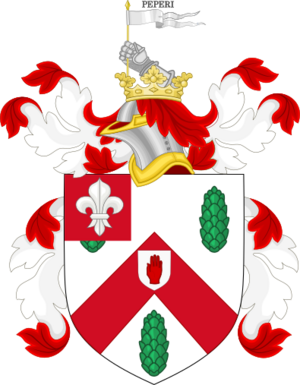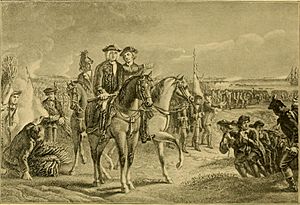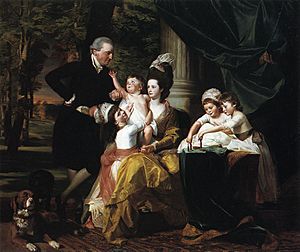William Pepperrell facts for kids
Quick facts for kids
William Pepperrell
|
|
|---|---|

1746, by John Smybert
|
|
| Chief justice of York County | |
| In office 1730–1759 |
|
| Governor's Council | |
| In office 1727–1759 |
|
| Massachusetts General Court | |
| In office 1726–1727 |
|
| Personal details | |
| Born | 27 June 1696 Kittery Point, Massachusetts Bay |
| Died | 6 July 1759 (aged 63) Kittery Point, Massachusetts Bay |
| Spouse | Mary Hirst (m. 17 March 1723) |
| Children | 4 |
| Occupation | Merchant, statesman and soldier |
| Signature |  |
| Military service | |
| Allegiance | |
| Branch/service | Colonial Militia British Army |
| Rank | Major general |
| Battles/wars | |
Sir William Pepperrell, 1st Baronet (born June 27, 1696 – died July 6, 1759) was an important merchant and soldier in colonial Massachusetts. He is best known for leading a military mission in 1745. This mission captured the French fortress of Louisbourg during a conflict called King George's War. Pepperrell was also a very wealthy person for his time. He owned enslaved people throughout his life.
Contents
Early Life and Family Business
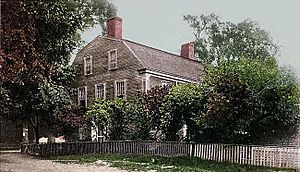
William Pepperrell was born in Kittery, Maine. At that time, Kittery was part of the Province of Massachusetts Bay. He lived in this area his entire life. His father, also named William Pepperrell, was a settler from Wales. His mother, Margery Bray, came from a wealthy merchant family in Kittery.
William Pepperrell learned about surveying and navigation. These skills helped him join his father's business. His father started as a fisherman's helper. Later, he became a successful shipbuilder and owned many fishing boats. The family also owned enslaved African-Americans. Their large home, built in 1682, still stands near Kittery Point.
In 1713, William Pepperrell's older brother passed away. This meant William had to take on more responsibility for the family business. He made their company one of the most successful trading businesses in New England. Their ships carried goods like lumber and fish to the West Indies and Europe. Throughout his career, Pepperrell typically owned about twenty enslaved people at any given time.
Public Service and Military Career
Pepperrell served in the Massachusetts militia, which was like a local army. He started as a captain in 1717. He then rose through the ranks, becoming a major, lieutenant-colonel, and finally a colonel in 1726. In 1723, he married Mary Hirst. She was the daughter of a rich Boston merchant and the granddaughter of Judge Samuel Sewall. They had four children together, but two of them died when they were very young.
Pepperrell was also involved in politics. He served in the Massachusetts General Court, which was the local government, from 1726 to 1727. He was a member of the Governor's Council from 1727 until his death in 1759. For eighteen of those years, he was the president of the Council. Even though he wasn't a trained lawyer, he became the chief judge of the Court of Common Pleas in 1730. He held this position until he died.
In 1734, Pepperrell became an active member of Kittery's First Congregational Church. He helped manage the church's business matters.
Leading the Siege of Louisbourg
During King George's War, Pepperrell suggested a plan to attack the French fortress of Louisbourg. This fortress was located on Île-Royale, which is now Cape Breton Island. He helped find volunteers, paid for supplies, and trained the soldiers for this important mission.
In April 1745, Pepperrell led the land forces as their commander-in-chief. He was supported by a Royal Navy fleet led by Captain Peter Warren. They surrounded Louisbourg, which was the strongest fort in North America at the time. After a six-week siege, they captured the fortress on June 16, 1745.
Recognition and Later Military Roles
Because of his success at Louisbourg, Pepperrell was made a baronet in 1746. This was a special honor, and he was the first and only American to receive this title. He was also given a colonel's rank in the British Army. This allowed him to create his own regiment of soldiers. However, this regiment was disbanded after Louisbourg was given back to the French. This happened because of a peace agreement called the Treaty of Aix-la-Chapelle (1748).
In 1749, Pepperrell visited London. He met the King and received a special silver gift from the City of London.
In 1755, during the French and Indian War, Pepperrell was promoted to Major General. He was in charge of defending the borders of Maine and New Hampshire. He played a key role in recruiting and training soldiers for the Massachusetts colony. Two regiments were formed locally. They were known as the 50th (Shirley's) and 51st (Pepperrell's) Regiments of Foot.
These regiments took part in difficult campaigns in 1755 and 1756. They spent the winter near Lake Ontario, occupying three forts. These forts were known together as Fort Pepperrell. A French force led by Montcalm surrounded and attacked them. Both regiments surrendered after their local commander was killed. Sadly, some prisoners were killed by the Native American allies of the French before they reached Montreal. Both regiments were later removed from the army list.
Between March and August 1757, Pepperrell served as the acting governor of Massachusetts. In February 1759, he was made Lieutenant-General. This was the highest rank an American had reached at that time. However, he was unable to take on any new commands. He passed away at his home in Kittery Point in July 1759.
Pepperrell and Enslaved People
The Maine Historical Society states that Pepperrell was a significant owner of enslaved people in Maine. His family owned up to 20 enslaved people at a time. While there is no proof he directly traded enslaved people, he did help fund the trade. In his will, Pepperrell allowed his wife to choose "any four of my Negroes" after his death in 1759. His wife, Lady Mary Pepperrell, later freed her enslaved people in her will in 1779.
Descendants and Legacy
William Pepperrell did not have a son to inherit his name. So, he adopted his grandson, William Pepperrell Sparhawk. His grandson agreed to change his last name to Pepperrell. He did this through a special law. The younger Pepperrell graduated from Harvard College in 1766. He became a merchant and took over most of his grandfather's businesses. He was also chosen to be a member of the Governor's Council. In 1774, the baronetcy title was given to him.
His wife, Elizabeth Royall, died at age 26 on October 9, 1775. This happened during a trip to England. They were fleeing the American Revolution as Loyalists. She was buried in The Old Burying Ground in Halifax, Nova Scotia.
The younger Pepperrell spent the rest of his life in London. He helped start the British and Foreign Bible Society. He died at his home in Portman Square in 1816.
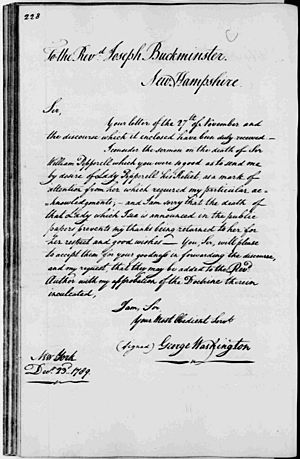
Places Named After Pepperrell
- Pepperrell's house is listed as a historic place.
- The town of Pepperell, Massachusetts is named after him.
- From 1762 to 1805, the town of Saco, Maine was called "Pepperellborough." He helped found this town. There is still a Pepperell Square in downtown Saco today.
- Pepperrell Air Force Base in St. John's, Canada, was named in his honor. It was a United States Air Force base from 1941 to 1960.
- Pepperell Street in Halifax, Nova Scotia, is also named after him. It runs parallel to Shirley Street, which is named after William Shirley.


